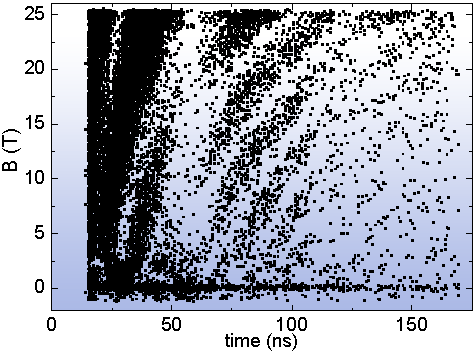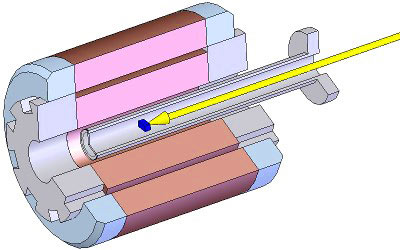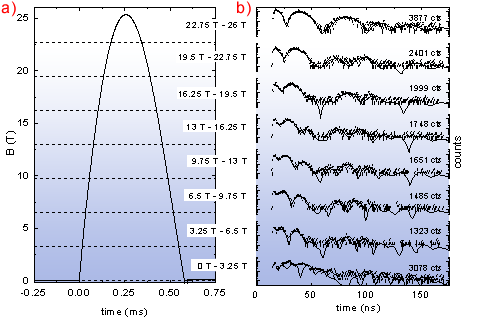- Home
- News
- Spotlight on Science
- Nuclear forward...
Nuclear forward scattering in pulsed magnetic fields
09-07-2007
Nuclear forward scattering of synchrotron radiation from Mössbauer transitions provides a unique tool for the study of magnetism, structure, and dynamics with a local probe. This spotlight presents the demonstration of nuclear forward scattering from 57Fe in high pulsed magnetic fields.
Share
Various synchrotron X-ray techniques like X-ray diffraction and EXAFS have already been applied within pulsed magnetic fields. The demonstration of nuclear forward scattering in pulsed fields adds another powerful tool for the study of matter in very high magnetic fields.
Nuclear forward scattering uses the time structure of synchrotron radiation to excite nuclear transitions (57Fe: 14.4 keV) with short flashes of synchrotron light and to detect the subsequent gamma-decay (τ57Fe = 141 ns) in the empty time window of 176 ns between the bunches in 16-bunch mode operation of the ESRF. Degenerate nuclear levels are split through hyperfine interactions of the nuclear moments with the surrounding solid. After excitation with coherent broadband radiation from the synchrotron source, this splitting leads to interference between the respective transition frequencies in the decay. Statistics on the number of counts as a function of the time after the exciting prompt pulse reveals the interference pattern as a time spectrum.
Pulsed magnetic fields are an economic and flexible way of providing very high magnetic fields, and they are the only means to reach fields beyond the limits of current superconducting and resistive magnet technology.
As nuclear forward scattering is a flux-limited method, it is necessary to average over thousands of field pulses in order to record time spectra. A crucial point was therefore the development of a high duty cycle minicoil by the sample environment support group. The coil warms up during the pulses due to Joule heating and the duty cycle is limited by the cooling time between the pulses. We achieve repetition rates as high as 6 pulses per minute at 25 T and 0.5 ms pulse duration, using a coaxial “slit-coil” assembly of two independent, series connected, reinforced coils to allow the penetration of liquid nitrogen into the gap between the coils for faster cooling (Figure 1).
Nuclear forward scattering is intrinsically a time-resolved method. In order to record nuclear forward scattering in the empty time window of 176 ns between the bunches in fields varying on the ms timescale, one has to perform photon count statistics in two dimensions: first, as a function of the time with respect to the exciting prompt pulse; and second, as a function of the time-varying magnetic field (Figure 2). We have therefore developed a detection scheme based on recording the full time information for each count and exploiting the entire duration of the magnetic field pulses. The magnetic field is recorded with an oscilloscope and the photons are detected with a time to digital converter using the magnetic field pulse as a common trigger. For the evaluation, we exploit the time information on three different scales: the time of the common trigger allows a replay of the experiment after completion, the time after the common trigger is used to assign the magnetic field value to each count and the time with respect to the last prompt pulse yields the time spectra.
 |
|
Figure 2: Nuclear forward scattering in pulsed magnetic fields for a sample of polycrystalline foil of ferromagnetic α-iron. Photon counting in two dimensions, as a function of the time with respect to the exciting prompt pulse and as a function of the time varying magnetic field. Each point represents a count in the B-t plane. The full time information for each count is used on three different scales: a) duration of the experiment: to perform a full replay of the experiment for later analysis (View the movie, QuickTime 1.5 mb); b) magnetic field pulse duration (0.5 ms); to assign a field value to each count through temporal correlation of the oscilloscope and the time to digital converter recordings; c) bunch spacing (176 ns): to observe the nuclear decay and to extract the nuclear forward scattering time spectra by evaluation of the time of the counts with respect to the last prompt pulse. |
We have demonstrated nuclear forward scattering in pulsed magnetic fields from a polycrystalline foil of ferromagnetic α-iron (57Fe) at the beamline ID18. The iron foil was placed perpendicular to the beam and the magnetic field was directed along the beam. About 17000 counts were recorded in approximately 4000 field pulses during half a day (Figure 2). Summing the counts in Figure 2 over field regions yields the time spectra (Figure 3). In iron, the magnetic hyperfine field at the nucleus is directed opposite to the magnetisation. The application of an external field therefore leads to a decrease of the observed magnetic hyperfine field. In the time spectra this manifests itself as a shift of the minima to later times (Figure 3).
In the future, nuclear forward scattering will be used to explore magnetic phase diagrams and to study the spin structure of magnetic materials in very high fields.
Authors
C. Strohm (a,b), P. van der Linden (b), R. Rüffer (b)
(a) E13, Technische Universität München (Germany)
(b) ESRF





